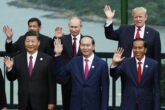October 29, 2018
The United States Should Rally Behind European Strategic Autonomy
It was May 2017 and it was the comment heard around the world. In the wake of a disastrous G7 Summit, German Chancellor Angela Merkel made a campaign stop at a packed beer tent in Bavaria and gave a now-infamous speech to a group of CSU supporters. “The era in which we could fully rely on others is over to some extent,” she declared, adding “we Europeans truly have to take our fate into our own hands.” It was only a few sentences, but it was enough to throw transatlanticists in Europe and the United States into a frenzy, lamenting the impending certain death of the transatlantic relationship. Since then, other European leaders have echoed Merkel’s sentiments. “Europe can no longer place its security in the United States’ hands alone,” French President Emmanuel Macron saidin Paris in August 2018. That same month, German Foreign Minister Heiko Maas penned a controversial op-ed stating “the US and Europe have been drifting apart for years.”
At the center of the debate regarding the future of the US-European relationship is the idea of European strategic autonomy. What strategic autonomy actually means for Europe and the transatlantic relationship is the subject of countless reports, op-eds, and expert roundtables on both sides of the pond. Alina Polyakova and Benjamin Haddad recently gave a pithy definition in Foreign Affairs that described it well: “Strategic autonomy means, first and foremost, a vision for Europe as an actor on the world stage capable of defending itself at home and pursuing its objectives abroad.” That is a worthy goal for Europe, and one the US should rally behind.
Although strategic autonomy remains largely unrealized, the idea is anything but new. The continent has been working toward it — albeit unenthusiastically — for years. At the 1998 St. Malo Summit, Jacques Chirac and Tony Blair signed a declaration that recognized the EU’s need to “have the capacity for autonomous action.” In June 2016, the EU espoused a new Global Strategy that focused on the EU untethering itself from the foreign policies of others, and put its own citizens’ interests first. Finally, in December 2017, the EU launched the Permanent Structured Cooperation (PESCO) to develop more efficiently the continent’s defense capabilities. If there is something new in all this, it is that Germany now seems to be trending toward putting distance between the US and Europe. Historically, they have been reticent to do so.
Read the full article in the European Leadership Network.
More from CNAS
-
A New Era of Strongman Rulers Is Upon Us
The consequences of strongman rule also seep into the fabric of economies and everyday life....
By Andrea Kendall-Taylor
-
Did Europe Change Trump's Mind on Ukraine?
The Trump administration made a major move this week in its announcement of sanctions on major Russian oil companies Rosneft and Luke Oil, along with 31 subsidiaries. This fol...
By Andrea Kendall-Taylor & Jim Townsend
-
Transatlantic Security / Energy, Economics & Security
Bloomberg Tech | Day 1 | Opening Night DebateGeoffrey Gertz, senior fellow, joined Bloomberg Tech's opening night debate and attempted to answer the question “Is Europe Too Late to Compete in the Chip War?” The U.S. and ...
By Geoffrey Gertz
-
A Tale of Two Russias: Views from Former Intelligence Officers
Four years into its war in Ukraine, Russia continues to escalate attacks on the Ukrainian population while also dialing up its hybrid campaign against Europe. In the last six ...
By Andrea Kendall-Taylor, Jim Townsend & Peter Schroeder




